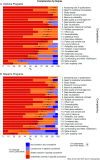Learning gaps among statistical competencies for clinical and translational science learners
- PMID: 33948238
- PMCID: PMC8057376
- DOI: 10.1017/cts.2020.498
Learning gaps among statistical competencies for clinical and translational science learners
Abstract
Introduction: Statistical literacy is essential in clinical and translational science (CTS). Statistical competencies have been published to guide coursework design and selection for graduate students in CTS. Here, we describe common elements of graduate curricula for CTS and identify gaps in the statistical competencies.
Methods: We surveyed statistics educators using e-mail solicitation sent through four professional organizations. Respondents rated the degree to which 24 educational statistical competencies were included in required and elective coursework in doctoral-level and master's-level programs for CTS learners. We report competency results from institutions with Clinical and Translational Science Awards (CTSAs), reflecting institutions that have invested in CTS training.
Results: There were 24 CTSA-funded respondents representing 13 doctoral-level programs and 23 master's-level programs. For doctoral-level programs, competencies covered extensively in required coursework for all doctoral-level programs were basic principles of probability and hypothesis testing, understanding the implications of selecting appropriate statistical methods, and computing appropriate descriptive statistics. The only competency extensively covered in required coursework for all master's-level programs was understanding the implications of selecting appropriate statistical methods. The least covered competencies included understanding the purpose of meta-analysis and the uses of early stopping rules in clinical trials. Competencies considered to be less fundamental and more specialized tended to be covered less frequently in graduate courses.
Conclusion: While graduate courses in CTS tend to cover many statistical fundamentals, learning gaps exist, particularly for more specialized competencies. Educational material to fill these gaps is necessary for learners pursuing these activities.
Keywords: Statistical competency; biostatistics; clinical and translational science; learning gaps; research training.
© The Association for Clinical and Translational Science 2020.
Figures


References
-
- Altman DG, Goodman SN, Schroter S. How statistical expertise is being used in medical research. Journal of the American Medical Association 2002; 21: 2817–2820. - PubMed
-
- Horton NJ, Switzer SS. Statistical methods in the journal. New England Journal of Medicine 2005; 18: 1977–1979. - PubMed
-
- Strasak AM, Zarnan Q, Marinell G, Pfieffer KP, Ulmer H. The use of statistics in medical research: a comparison of the New England Journal of Medicine and Nature Medicine . The American Statistician 2007; 61: 47–55.
Grants and funding
LinkOut - more resources
Full Text Sources
Research Materials
Miscellaneous
